Cat’s Request review
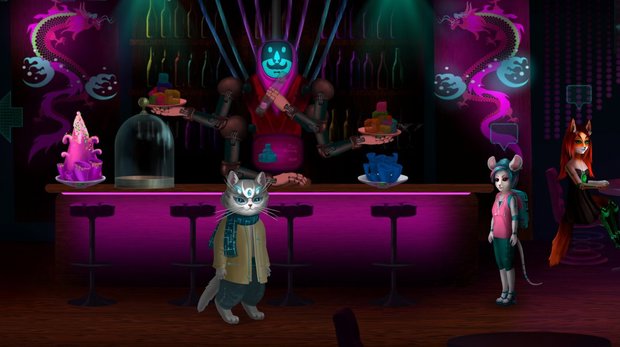
- 0 Comments
Too short to be fully developed, this beautiful feline puzzle adventure will still scratch the adventuring itch for a couple of hours
How far would you go to save someone you love? Or, perhaps the more interesting question is, how far do you think your cat would go? Cat’s Request attempts to answer that question – sort of. Partly developed plot threads left hanging without conclusion and a less-than-satisfactory translation can stymie the experience somewhat, but thanks to its eclectic art direction and clever puzzles, this two-hour cat-scratch-fever dream may just still be a trip worth taking, particularly for fans of felines.
Cat’s Request chronicles a day in the life of Ash, an anthropomorphic engineer cat who lives in a modest-sized apartment with his AI companion, Root, who has no physical form but appears on-screen as a translucent fellow feline. Upon starting, you are invited to stroll around the apartment, looking at Ash’s belongings and have him offer commentary on his various tools and projects, getting a feel for what kind of world you will be exploring. Cats are intelligent, bipedal, and even enjoy swimming in this universe. While the initial introduction is straightforward enough, the history of these star-faring cat people becomes a big part of the gaming experience, and yet is strangely irrelevant to the central plot. The game proper begins when Ash turns on the television and a news broadcast states that AI persons living on the net will soon be prohibited. Thus, Ash needs to find Root an artificial body in which she can live before the ban comes into effect.
Heading out of the apartment, Ash takes the elevator from the top floor of his building down to the street, where the camera pulls back to reveal a sweeping vista of a densely arranged and neon-lit cyberpunk city. Beautiful as the hand-drawn skyline is, the city is just as interesting at street level. The city is populated by cyborgs, aliens, and other anthropomorphic animal citizens. Even the environments themselves have stories to tell, with alien plant life, pawn shop inventory, and patrons of a local cafe all having their own backstories. The written language and multicultural/transhuman (erm, transfeline?) society is well conceived, and it feels like developer BOV put a lot of work into realizing the world, even if we only get to explore a few avenues of it. The game isn’t just limited to the city, though, eventually spanning multiple planets, from lush jungle worlds to ancient desert ruins.
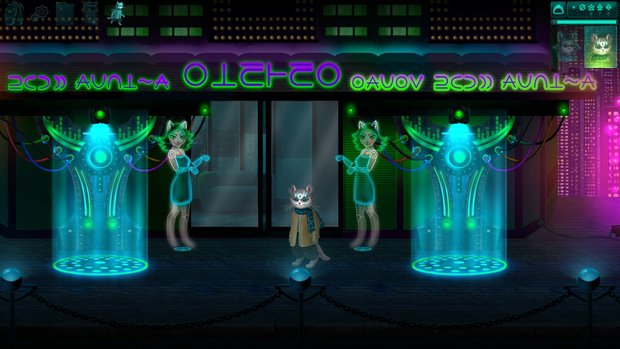
After visiting a few shops, Ash discovers that an artificial body for Root is well out of his price range, and thus becomes sidetracked with sub quests and other plot threads to acquire the necessary funds. Cat’s Request is relatively open in terms of what order you can complete these objectives, and some can be done multiple times, like getting a part time job cleaning a cafe (which consists of merely walking from one end to the other, picking up trash on the floor) for extra money – money needed for cab fare to new locations, to buy cyber candies for Root and food to restore Ash’s mental health, or to buy other plot-essential items.
Though many tasks are optional, the main quest gradually sees Ash uncover a conspiracy taking hold of the populace’s minds, thereby becoming the root cause for the upcoming AI ban. Side quests usually have little to do with this storyline, however, and the contrast between the two is a bit jarring. Uncovering the secrets of Ash’s ancestors on one planet, shaking hands with a jellyfish underwater on another, and looking for a fruit-based dessert recipe for the local cafe are all diverting world-building detours, but they’re relatively short distractions that go absolutely nowhere.
Gameplay follows a straightforward side-scrolling format, controlling Ash in real time as you walk (or run) left or right on a set plane. You can stop and investigate points of interest (highlighted by the cursor) to get commentary, clues, or items. Controls work well on console, with the left stick being used for movement and the right for the cursor. When you walk to a door/edge of a screen, the cursor will even zoom over to the exit point on its own as a nice quality-of-life feature. On PlayStation 5, the DualShock 5’s rumble feature is used to connote when goals are completed, which is a nice little addition.
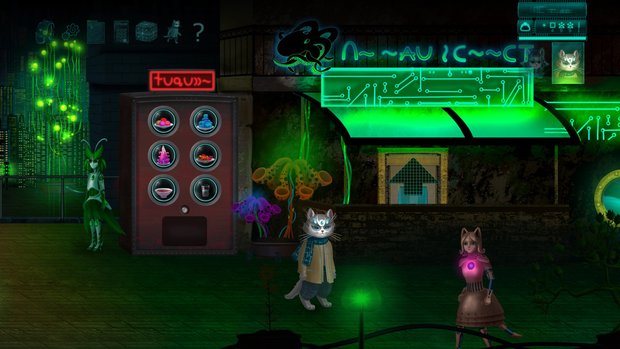
There is no real tutorial, but there is an in-game instruction manual. This does a good job of explaining systems like switching between Ash and Root, using items from your inventory, and what the different health bars mean. Still, an actual tutorial would have been preferable, as players will likely find themselves stuck at some point with no idea that they have an entire gameplay system at their disposal, in tandem with the base pointing and clicking. Root, for example, is a playable character, but instead of interacting with the environment physically, has abilities that Ash does not, including examining items in Ash’s inventory. Switching between Ash and Root is done with the click of a button, but why and where you would need to use her expertise is only explained in the in-game manual.
Ash’s quest log is also stored alongside the in-game manual, in the same menu as his inventory. The log does not give you a marker or wayfinder of where to go, but is clear enough in its clues of what needs to be accomplished. Completed quests are crossed off as well, making it easy to keep track of what you need to do. You can also access your phone to dial numbers or use a quick travel device (unlocked later in the game) to avoid taxi fare from in the menu. Notes are kept in this menu too, and are handy for reviewing events that have transpired.
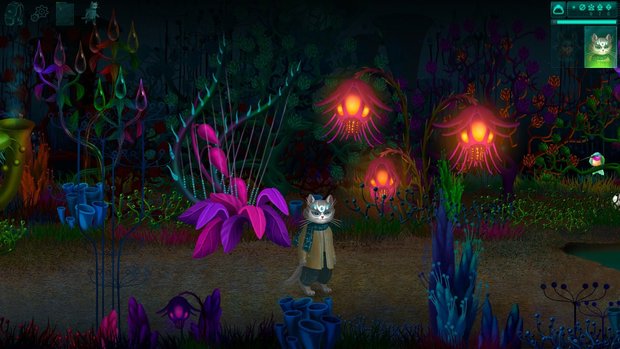
There are many obvious points of interaction, like vending machines, NPCs, or even plants that need watering. The number of optional possibilities is enjoyable, and it can be nice to just sit back and soak in the atmosphere of the street/swamp/junkyard as robots chug by and neon lights flicker. There aren’t any mini-games, but there are different items you use to interact with, like a recording device a musician gives you to capture interesting sounds in the environment for her.
Cat’s Request can be a bit of a pixel hunt at times, however. It is often easy to miss something you need to pick up, whether an essential item or a side quest clue. The environments, as packed with detail as they can be, are not very big, and jumping between them to scour for clues is a straightforward, though sometimes tedious, affair. At least the game comes with four save slots, and saving can be done at any time, allowing you to experiment with different routes and go back if you find a more optimal method for solving a puzzle.
Hopping between planets is less exciting than it sounds, happening via a Stargate-esque portal unlocked at first, and then by the aforementioned quick travel item added to your inventory later on. There is no cutscene showing Ash traversing the cosmos; rather, you just pick a point and are immediately teleported there. There is one point where you get to travel into space to harvest scrap parts off of satellites. Having Ash float about in his spacesuit is fun, but the gameplay remains locked to a 2D plane and ultimately doesn’t feel any different from the rest of the experience.
Ash can activate Root at most points in the game. Root’s projection in the environment is invisible to NPCs, but she can see things Ash cannot, like viruses. She can also hack computers to get information, as well as access people’s minds by exploring their psyches via a Dali-esque landscape and piecing together bits of their characters represented by objects and puzzles. It’s a neat change from the more science-fictiony locales, and another of the game’s artistically interesting ideas.
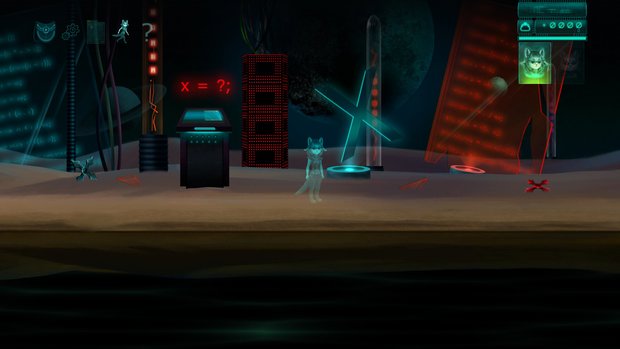
Ash has a mental illness metre, displayed in the upper right alongside the amount of money – spent or acquired through work or pawning items – you possess. (Numbers have their own unique symbols in Cat’s Request, which is another nice bit of worldbuilding.) Mental health is affected by plot points and time. Selling a sentimental item, for example, will reduce Ash's mental health, while eating food or completing a task will increase it. I’m not sure if this metre can fully deplete, but I spent quite a bit of time walking around with low health and there seemed to be zero consequence for doing so. Really this metre only comes into effect once during the game’s two-hour play time, making it feel like an underdeveloped concept.
A particular quest requires Ash’s mental health to be full in order to proceed, with a computer gatekeeping an area against those mentally unfit to enter. The text does not make that clear, though, saying only that Ash’s health needs to be improved. Increasing his status can require travelling back and forth between areas to purchase food from a vending machine, and I made several such trips, only to be rejected again each time before understanding what the game was really asking for. Backtracking doesn’t take long, but the lack of clarity was an irritation that could have been rectified through clearer communication.
Puzzles are otherwise numerous and varied, tasking you with inputting passwords, finding items to solve environmental puzzles, and opening locked areas with keys. You never combine items in Ash’s inventory, though you may have to use multiple keys or objects on a single obstacle. Rescuing someone from the sewer, for example, requires several items to open the manhole cover, while another section requires you track down two halves of a numeric code by interrogating different NPCs. One puzzle involving finding ancient relics in the ruins of a desert cat planet had me stumped for a while, but it was more because I had neglected to notice a hotspot rather than how the puzzle actually worked. You can chase different leads at the same time in Cat’s Request, and while they don’t all move the main plot forward, they are nevertheless interesting to undertake and satisfying to solve.
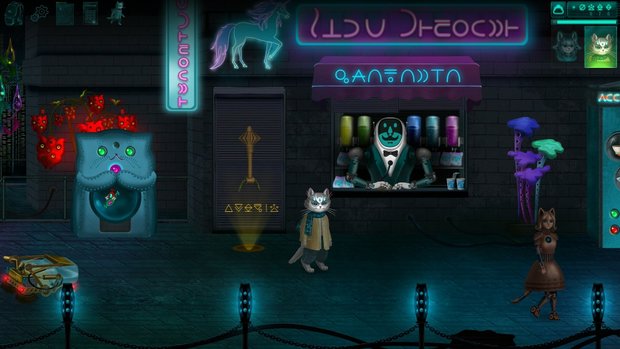
I did encounter an obvious glitch in my playthrough. Though it never crashed the game, I found an item that respawned and could be picked up multiple times. There are numerous spelling errors and inconsistencies in the text as well. While minor and still mostly understandable, it does break immersion, such as when a character named Cora introduces herself as Kora, despite the real name being labeled right above her in the text box.
There is no voice acting, but it’s fine to leave the animal and robot cast to one’s imagination. The soundtrack consists of downbeat techno and synth tunes, with each screen changing the track. The music suits the cyberpunk/spacefaring setting perfectly, and is a delight to listen to.
The game looks every bit as good as it sounds, as the parallax layers of the world are incredible, and all of the characters you meet throughout have unique designs. The digital art is mostly comprised of still images, animated by paper-doll movements and/or a slight warping or bobbing, like the alien plants or water. Despite the stilted movement and complete lack of facial expression or body language, the sense of life and dynamic activity is notable. This lack of expression does compound with the often directionless drama, however, making the plot feel lifeless at critical points.
Avoiding any major spoilers, the game ends with you accusing one of several NPCs of hacking the city’s central computer. A wrong guess results in a single art frame and a short block of text explaining that you imprisoned the wrong person before booting you back to the title screen. Once the correct culprit is chosen (you can simply reload your game to try again), the result is the same: a single picture and short text description stating that you reached the good ending. There is no closure to any other major plot points, whether a new body for Root or Ash’s work with the authorities. It’s a shame that after all the great effort that went into worldbuilding, Cat’s Request ends as nothing more than a haphazardly arranged whodunnit with little buildup or suspense.
Final Verdict
Cat’s Request is a beautiful and interesting world to spend a couple of hours in. There are some frustrations to be had thanks to a lack of polish and user-friendliness in places, but even compounded by the disjointed plot and abrupt ending, it is still a mostly enjoyable experience thanks to its lively alien/feline universe, puzzle variety, and open-ended progression. It’s more a sketch of a bigger game than a fully realized one in its own right, but as a passion project it shows promise with its ideas, and is worth experiencing for those in the mood for a cyberpunk adventure for the brief time it lasts.
Hot take
Cat’s Request is a lovely, imaginative science fiction fever dream that spreads itself a bit too thin but is nevertheless an enjoyable gaming experience over the course of its too-brief two-hour runtime.
Pros
- Fully realized alien universe of anthropomorphic beings
- Nice puzzle variety, including switching between playable characters
- Manual save slots are welcome
- Vibrant visuals and immersive downbeat soundtrack
Cons
- Certain elements are underdeveloped and poorly explained
- Grander universe is introduced but only superficially explored
- Minor mistranslations and glitches break immersion
- Short play time abruptly ends with little closure
Drew played Cat’s Request on PlayStation 5 using a review code provided by the game's publisher.


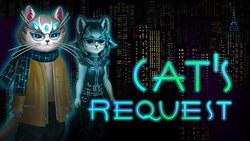








0 Comments
Want to join the discussion? Leave a comment as guest, sign in or register in our forums.
Leave a comment